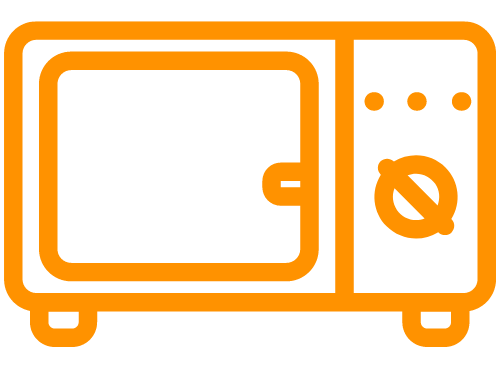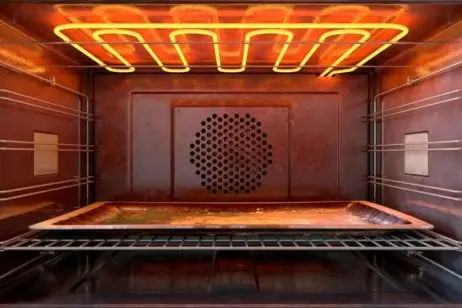In today’s fast-paced world, convenience is critical. We constantly seek ways to streamline our daily tasks, and household chores are no exception. When cleaning our ovens, a remarkable innovation has emerged – the self-cleaning oven. This revolutionary appliance promises to eliminate the hassle and elbow grease typically associated with oven cleaning.
This comprehensive guide will explore the question: “Can Self-Cleaning Oven Kill You?” We will explore how they work, discuss their potential dangers, and provide essential safety precautions to ensure worry-free usage. Furthermore, we will explore alternative cleaning methods for those seeking greener options, including a homemade oven cleaner solution.
Follow the table of contents to explore and effortlessly find specific sections within the article.
Table of Contents
ToggleWhat Is A Self-Cleaning Oven?
A self-cleaning oven is a modern marvel that has transformed how we clean our ovens. Gone are the days of laborious scrubbing and harsh chemical cleaners. With a self-cleaning oven, you can say goodbye to the hours spent on your knees, tirelessly scrubbing away grease and baked-on food residues.
This innovative kitchen appliance is designed to take the hassle out of oven cleaning using advanced technology to tackle the toughest grime. The self-cleaning feature utilizes high temperatures to effectively burn away and reduce food particles and stains to ash. It eliminates the need for manual scrubbing, saving you time and effort.
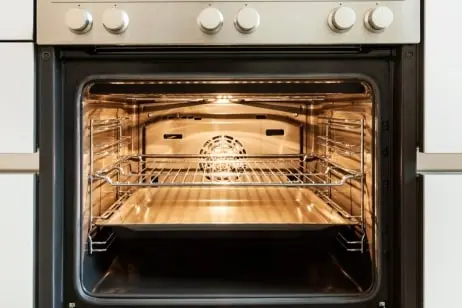
How a Self-Cleaning Oven Works?
A self-cleaning oven uses high heat and advanced technology to clean itself efficiently. The process involves a specific cleaning cycle built into the oven’s design. Here’s a closer look at how a self-cleaning oven works:
- Activation: To initiate the self-cleaning process, you typically need to select the self-cleaning function on the oven’s control panel. A dedicated button or a specific setting may indicate this function.
- Locking Mechanism: Once the self-cleaning cycle is activated, the oven’s door locks automatically to ensure safety. This prevents accidental opening of the oven during the high-heat cleaning process.
- Heating Phase: The oven begins to heat up, reaching extremely high temperatures, usually between 800 and 900 degrees Fahrenheit (427 to 482 degrees Celsius). This intense heat is essential for effectively breaking down and burning away food residues, grease, and other built-up stains inside the oven.
- Incineration of Debris: As the oven heats up, any organic matter, such as food particles or spills, is reduced to ash. The high temperatures cause the debris to break down and turn into a powdery residue, making cleaning easier once the cycle is complete.
- Length of Cleaning Cycle: The duration of the self-cleaning cycle can vary depending on the oven model and the level of dirt and grime. Typically, it lasts several hours to clean the oven interior thoroughly. Some newer models offer shorter cleaning cycles for lighter cleaning needs.
- Ventilation: Throughout the cleaning cycle, the oven’s ventilation system helps remove the smoke and odors produced during incineration. It’s essential to ensure the kitchen has enough air flow by opening windows or turning on exhaust fans.
- Cool-Down Period: The oven enters a cool-down phase after the cleaning cycle. The oven’s internal temperature gradually decreases, allowing the ash residue to cool down and become easier to handle.
- Cleaning the Residue: Once the oven has cooled down sufficiently, you can safely open the door. You may use a wet sponge or rag to remove the ash residue from the oven’s interior surfaces. Some ovens may have a removable ash collection tray or panels that can be cleaned separately.
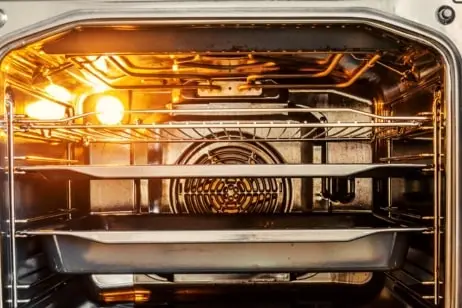
Can Self-Cleaning Oven Kill You?
No, a self-cleaning oven cannot directly kill you. The high temperatures during the self-cleaning cycle are not harmful if the oven is used correctly and all safety precautions are followed. However, it is essential to be aware of the potential dangers and risks associated with self-cleaning ovens, which we will discuss in the following section.
Why is this So Dangerous To Use?
While self-cleaning ovens offer convenience and efficiency in cleaning, they come with potential dangers if not used properly. Here are a few reasons why self-cleaning ovens can be dangerous:
High Temperatures:
Self-cleaning ovens reach incredibly high temperatures, typically between 800 and 427-482 degrees Celsius (about 900 degrees Fahrenheit). These temperatures can cause severe burns if one touches the oven’s interior surfaces during or after the cleaning cycle. It is crucial to avoid touching the oven or opening it while the self-cleaning cycle is active or still hot during the cool-down period.
Release of Fumes:
Food particles, grease, and other residues inside the oven are incinerated during self-cleaning, releasing potentially harmful fumes. These fumes can include carbon monoxide and volatile organic compounds (VOCs). Although the levels of these fumes are usually minimal and safe in well-ventilated areas, it is essential to ensure proper ventilation by opening windows or using exhaust fans to prevent any potential health risks.
Fire Hazards:
High temperatures and prolonged heating in self-cleaning ovens can pose a fire hazard if flammable materials or substances are left inside or near the oven. Removing any items, such as food, cookware, or kitchen towels, before initiating the self-cleaning cycle. Additionally, nearby flammable materials should be kept at a safe distance to prevent the risk of ignition or fire.
Electrical Malfunctions:
Occasionally, self-cleaning ovens may experience electrical malfunctions or failures, leading to potential hazards. It is essential to regularly inspect and maintain the oven, ensuring that all electrical components are in good condition and functioning correctly. If any signs of malfunction are noticed, it is advisable to contact a professional for repairs.
To ensure the safe usage of self-cleaning ovens, it is crucial to read and follow the manufacturer’s instructions, adhere to recommended safety precautions, and exercise caution throughout the cleaning process. By understanding the potential risks and taking appropriate measures, one can minimize the dangers associated with self-cleaning ovens and enjoy their benefits with peace of mind.
Safety Precautions for Using Self-Cleaning Ovens
A self-cleaning oven can be a convenient and efficient way to keep your oven clean. However, it’s crucial to prioritize safety when utilizing this feature. Following proper safety precautions can minimize potential risks and ensure a safe environment for yourself and your home.
1. Read the Manufacturer’s Instructions
Before using a self-cleaning oven, carefully read and familiarize yourself with the manufacturer’s instructions and guidelines. Each oven may have specific safety recommendations and procedures that should be followed. Pay close attention to any warnings, recommended cleaning durations, and ventilation requirements mentioned in the manual.
2. Remove Flammable Materials
Remove flammable materials from the oven and its vicinity before starting the self-cleaning cycle to prevent fire hazards. This includes removing food, cooking utensils, kitchen towels, and other items that could catch fire or emit harmful fumes when exposed to high temperatures.
3. Avoid Direct Contact:
During and immediately after the self-cleaning cycle, avoid direct contact with the oven’s interior surfaces, as they can reach incredibly high temperatures and cause burns. Refrain from opening the oven or touching its components until it completely cools.
4. Supervise and Educate
If you have older children who can understand safety instructions, provide them with clear guidelines on the hazards of a self-cleaning oven. Emphasize the importance of not touching or opening the oven during cleaning. Supervise younger children at all times and explain the dangers associated with the oven’s high temperatures.
5. Protect Pets
Pets, curious cats, and dogs may be attracted to the warmth of a self-cleaning oven. To prevent accidental burns, ensure your pets are kept in a separate area from the kitchen during cleaning. Consider using pet gates or crates to create a safe space for them.
6. Schedule Cleaning During the Absence
To minimize the risk of accidental contact or exposure to fumes, consider scheduling the self-cleaning cycle when you and your family are away from home. This ensures that the oven has enough time to cool down before anyone enters the kitchen, reducing the chances of burns or inhalation of any residual fumes.
How to Use Frigidaire Self Cleaning Oven? Complete Guide
Self-Cleaning Oven Alternatives
While self-cleaning ovens offer convenience and efficiency, they may not suit everyone. Whether you have an older oven model that lacks a self-cleaning feature or prefers alternative cleaning methods, there are effective alternatives to achieve a sparkling oven. This section will explore various alternatives to self-cleaning ovens, providing options to keep your oven clean and well-maintained.
1. Manual Cleaning:
The traditional manual cleaning method remains a reliable option for oven maintenance. This involves using oven cleaners, baking soda, vinegar, or a combination of these ingredients to tackle stubborn grease and food residues. Simply apply the cleaning solution to the interior surfaces, let it sit for the recommended duration, and scrub away the grime using a sponge or brush. Manual cleaning requires some elbow grease but allows you to control the cleaning process.
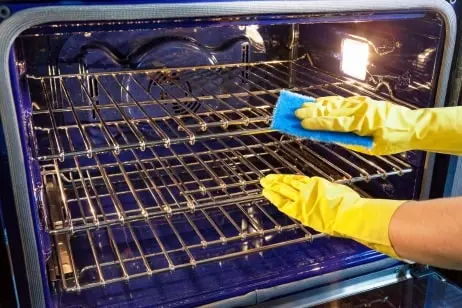
2. Steam Cleaning:
Steam cleaning can be an effective alternative if you prefer a gentler approach. Steam cleaning ovens utilize the power of steam to loosen and dissolve grease and grime. This method involves filling a container with water, placing it in the oven, and activating the steam cleaning function. The steam generated helps to soften baked-on residue, making it easier to wipe away with a cloth or sponge.
3. Natural Cleaners:
Natural cleaners offer a viable alternative for those who prefer eco-friendly cleaning solutions. Ingredients such as lemon juice, baking soda, vinegar, and hydrogen peroxide can be combined to create homemade oven-cleaning solutions. These natural cleaners are non-toxic and can effectively break down grease and grime, providing a safe and environmentally friendly option.
4. Professional Oven Cleaning:
If you prefer to leave the cleaning to the experts or have a heavily soiled oven that requires specialized attention, hiring professional oven cleaning services is an excellent alternative. Professional cleaners have the tools, equipment, and expertise to clean your oven deep, ensuring optimal performance and a pristine finish. They use specialized cleaning agents and techniques to remove stubborn stains and restore your oven to its original condition.
5. Prevention and Regular Maintenance:
Prevention and regular maintenance are critical to minimize the need for intensive cleaning. Place oven mats or liners on the bottom of your oven to catch spills and drips, making them easier to clean. Regularly wipe down the oven after each use to remove any fresh spills before they harden. Additionally, performing routine maintenance tasks such as checking seals, cleaning burner elements, and replacing filters can help prolong the cleanliness and functionality of your oven.
In short
In conclusion, it is crucial to prioritize safety when using self-cleaning ovens. While these appliances offer convenience and efficiency in maintaining a clean kitchen, understanding the potential risks and following the recommended safety precautions is paramount. You can mitigate the potential hazards associated with self-cleaning ovens by implementing proper ventilation, removing flammable materials, and keeping a fire extinguisher readily available.
Safety should always be a top priority when utilizing any household appliance, including self-cleaning ovens. By following these safety instructions, you can enjoy the benefits of an oven that cleans itself while keeping yourself and your family safe.
Read More
Can You Put a Plate in the Oven? Discover the Guidance
